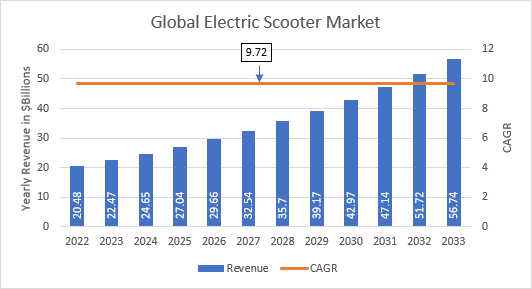GLOBAL REPORT

The global electric scooter market is growing at a rate that will enable it to surpass $56 billion by the end of 2033, according to a forecast by. Power Systems Research. The forecast predicts a projected growth rate of 9.72% by 2033.
This high growth rate is attributed to the rising demand for electric vehicles because of the increasing worldwide population.
An Electric Vehicle (EV) is a vehicle that runs on electricity/battery power. Electric vehicles have low running costs due to fewer moving parts and are environmentally friendly as they use little or no fossil fuels. Some EVs use lead-acid or nickel-metal hydride batteries, but lithium-ion batteries are now used in battery-powered electric vehicles for their long life, excellent energy storage, and low self-discharge rate.

Source: Power Systems Research
Global Demand Drivers.
Several local and global factors are driving the e-scooter market.
- Rising air pollution caused by increasing traffic congestion. World Health Organization’s data shows that most of the global population (99%) breathes air that exceeds WHO guideline limits and contains high levels of pollutants, with low and middle-income countries being most at risk. Electric scooters offer a practical solution for short-distance commuting, providing users with the flexibility to navigate through traffic and reach their destinations quickly. Compact size and maneuverability make them ideal for crowded urban environments.
- Rising desire of individuals to become more independent by owning two-wheeler transportation. The factors that are contributing to this tendency are fear of public transportation services, financial restrictions, and simple financing options available to purchasers.
- Government initiatives to reduce the use of fuel to decrease dependency on other countries for oil. The increasing cost of fuel production decreases economic growth, thereby increasing poverty levels. The use of electric scooters reduces fuel costs, increases the efficiency of vehicles, and decreases environmental pollution.
- Increasing urbanization with advancements in lifestyle and rising living standards of people owing to more disposable income leads to economic growth in the region. Rising economic standards increase the spending capacity of people for goods including electric scooters.
- Concern about global warming. Increasing demand for fuel-efficient vehicles, coupled with growing concerns over greenhouse gas and carbon emissions.
- Advancements in battery technology have improved the performance and range of EV scooters. Lithium-ion batteries have become more affordable, lightweight, and capable of delivering extended mileage. This has alleviated range anxiety and increased the appeal of electric scooters as a viable mode of transportation.
Challenges.
Even though there are several strong drivers of growth for EV scooters, there are several factors that could slow the growth of EV scooters.
- Lack of infrastructure in emerging countries. There is little advanced infrastructure in many countries. There is a huge need for charging stations at every 50 km, about the limit of electric scooters. This is not sufficient for a long journey.
There are potential solutions at hand, however. Battery swapping could eventually play a role in solving infrastructure issues and range anxiety.Manufacturers are developing their recharging networks in developing countries and Governmental participation will also be needed to develop these networks.
- High cost of electric scooters.The high cost can still be out-or-reach for individuals in developing countries.
- Lack of good road network.Bad roads will increase maintenance costs.
Battery Type.
The Li-Ion segment is expected to have the largest share of the electric scooter market over the forecast period. The growth of the segment can be attributed to the lithium-ion battery chemistry, quick and efficient charging, long battery life, and low maintenance costs. Lithium batteries charge with nearly 100% efficiency, compared to the typical lead-acid batteries 85% efficiency.
Conclusion.
Lack of charging infrastructure will be the largest obstacle to the expansion of the e-scooter global market. The most important consideration for any user is the ease with which an e-scooter can be charged anywhere at any time. Most emerging countries lack the required charging stations. PSR
Mike Aistrup is Senior Analyst at Power Systems Research


